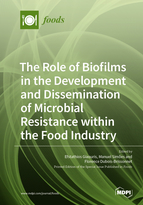The Role of Biofilms in the Development and Dissemination of Microbial Resistance within the Food Industry
A special issue of Foods (ISSN 2304-8158). This special issue belongs to the section "Food Microbiology".
Deadline for manuscript submissions: closed (31 January 2019) | Viewed by 46080
Special Issue Editors
Interests: biofilms; antimicrobial resistance and tolerance; foodborne bacterial pathogens; virulence and pathogenesis; disinfection; novel (green) antimicrobials; food hygiene and safety; quorum sensing; intercellular interactions; bacterial stress adaptation
Special Issues, Collections and Topics in MDPI journals
Interests: antimicrobial agents; emerging antimicrobial strategies; antimicrobial resistance; biofilms; plant secondary metabolites
Special Issues, Collections and Topics in MDPI journals
Special Issue Information
Dear Colleagues,
Biofilms are multicellular sessile microbial communities embedded in hydrated extracellular polymeric matrixes. This is common in microbial life in most environments, while those formed on food-processing surfaces are of considerable interest in the context of food hygiene. Biofilm cells express properties that are distinct from planktonic ones; one such property is their notorious resistance to antimicrobial agents. Thus, a special feature of biofilms is that, once they have been developed, these are hard to eradicate, even when typical sanitization procedures are regularly applied. A great deal of ongoing research has investigated how and why surface-attached microbial communities develop such resistances, and several mechanisms are to be acknowledged (e.g., heterogeneous metabolic activity, cell adaptive responses, diffusion limitations, genetic and functional diversification, and microbial interactions). This Special Issue aims to deliver deep insight into all these mechanisms, focusing on the role of biofilms in the development and dissemination of microbial resistance within the food industry.
Assist. Prof. Dr. Efstathios D. Giaouris
Assist. Prof. Dr. Manuel V. Simões
Prof. Dr. Florence Dubois-Brissonnet
Guest Editors
Manuscript Submission Information
Manuscripts should be submitted online at www.mdpi.com by registering and logging in to this website. Once you are registered, click here to go to the submission form. Manuscripts can be submitted until the deadline. All submissions that pass pre-check are peer-reviewed. Accepted papers will be published continuously in the journal (as soon as accepted) and will be listed together on the special issue website. Research articles, review articles as well as short communications are invited. For planned papers, a title and short abstract (about 100 words) can be sent to the Editorial Office for announcement on this website.
Submitted manuscripts should not have been published previously, nor be under consideration for publication elsewhere (except conference proceedings papers). All manuscripts are thoroughly refereed through a single-blind peer-review process. A guide for authors and other relevant information for submission of manuscripts is available on the Instructions for Authors page. Foods is an international peer-reviewed open access semimonthly journal published by MDPI.
Please visit the Instructions for Authors page before submitting a manuscript. The Article Processing Charge (APC) for publication in this open access journal is 2900 CHF (Swiss Francs). Submitted papers should be well formatted and use good English. Authors may use MDPI's English editing service prior to publication or during author revisions.
Keywords
- biofilms
- microbial resistance
- foods
- disinfection
- stress adaptation
- antimicrobial agents









